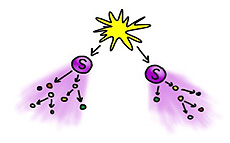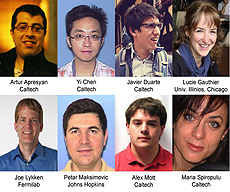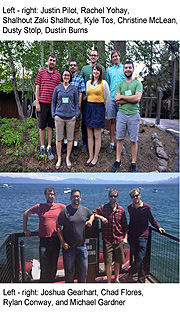Slicing parameter space with a razor
 |
| Supersymmetric particles produced in proton collisions might have any of a variety of decay patterns, but the total energy of all decaying particles corresponds to the mass of the first particle in the cascade.
|
Supersymmetry is hard to kill. It is more general than most theories of physics beyond the Standard Model: It is the basic idea that particles and forces are fundamentally the same thing but appear different because something creates an effective distinction between them, similar to the way that the Higgs boson creates an effective distinction between the electric and weak parts of the electroweak force. For supersymmetry, that "something" is unknown — many different models of supersymmetry breaking have been proposed and others could be thought up tomorrow. Each variant, including minor variations in numerical parameters, yields different decay patterns involving different cascades of particles.
Seekers of supersymmetry are faced with a dilemma: Pick a model of supersymmetry breaking and hope you're lucky enough to find it, or look at a quantity that is sensitive to a broad class of models, but with less statistical sensitivity. If you pick a specific model and don't find it, you can set a precise exclusion limit, but only on one model — supersymmetry itself remains elusive. Broad searches, on the other hand, are hard to formulate. You have to think of a signature that is shared by many supersymmetric models yet is different enough from the Standard Model to clearly claim a discovery or set a tight limit.
One technique, dubbed "the razor," shares aspects of both. It makes weak assumptions about the mechanism of supersymmetry breaking but also makes a sharp distinction between supersymmetric particles and the Standard Model. Assuming that supersymmetric particles are within reach of the LHC (like squarks and gluinos), and that they are produced in pairs (R-parity is not violated), and that they decay in cascading chains (as many variants of supersymmetry do), they would show up in LHC collisions as two rough bundles of particles, each with an energy that corresponds to the mass of the first supersymmetric particle in the chain. Different models predict different decay patterns within each bundle, but this technique looks only for the bundles.
A group of CMS scientists selected events using the razor technique and found them to be consistent with the Standard Model. This cuts out a broad range of supersymmetric models, many more than a focused technique would. There are still others that might evade the razor's weak assumptions, but the remaining space is getting thin.
—Jim Pivarski
 |
| The U.S. physicists pictured above made significant contributions to this analysis.
|
 |
| These graduate students and postdocs from the University of California, Davis helped make the recent annual meeting of the US CMS collaboration a fantastic success.
|
|